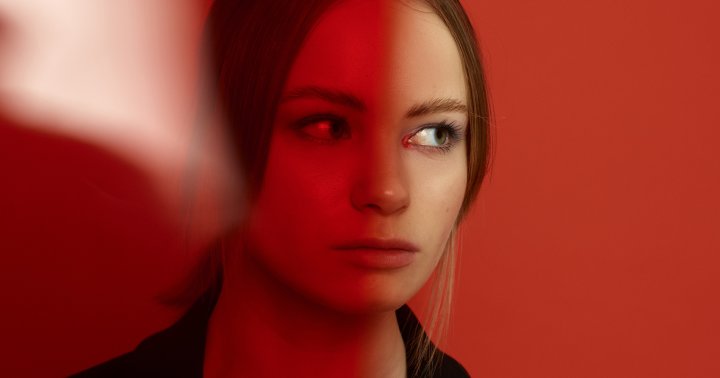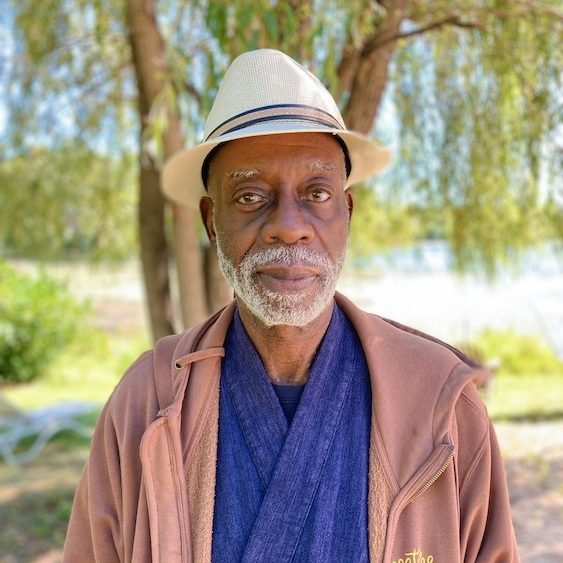Tara, the Saviour, and Vajrayogini the Sarvabuddhadakini: how are they different, and how are they the one? The importance of Female Buddhas: Wisdom personified
Vajrayogini “is the original and prototypical female Buddha of the Tantric pantheon… compassionate, all-knowing, and supremely blissful… Vajrayogini reigns supreme as the Sarvabuddhadakini, ‘Dakini Whose Essence is That of All Buddhas.’” [2] On the other hand, Tara appears as...

 Vajrayogini and Green Tara can be thought of as two aspects of the Wisdom Female Buddha.
Vajrayogini and Green Tara can be thought of as two aspects of the Wisdom Female Buddha.Vajrayogini “is the original and prototypical female Buddha of the Tantric pantheon… compassionate, all-knowing, and supremely blissful… Vajrayogini reigns supreme as the Sarvabuddhadakini, ‘Dakini Whose Essence is That of All Buddhas.’” [2]
On the other hand, Tara appears as the Divine Mother, the Female Buddha who can save sentient beings — who cares for us ferociously as our own mother would — the Saviour Buddha. Both are “action-oriented”: Green Tara with her one leg extended, ready to leap to the aid of her followers, and Vajrayogini who dances in the bliss of Shunyata, to show us the way to Enlightenment.
Most teachers and practitioners see Tara and Vajrayogini as different aspects of the same Enlightened Body, Speech and Mind — the same Ultimate Truth. The key differences are in visualized aspects, and practice emphasis. Vajrayogini, for example, embraces the important concept of “bliss.” [See section on bliss, below.]
His Holiness Sakya Trizin explains: “In order to help different types of people and situations, the Buddha takes different forms. Some yidams are in wrathful form, some yidams are in peaceful form, and some yidams are female deities, like Tara. Yidams are different forms of the Buddha.” [4]
\
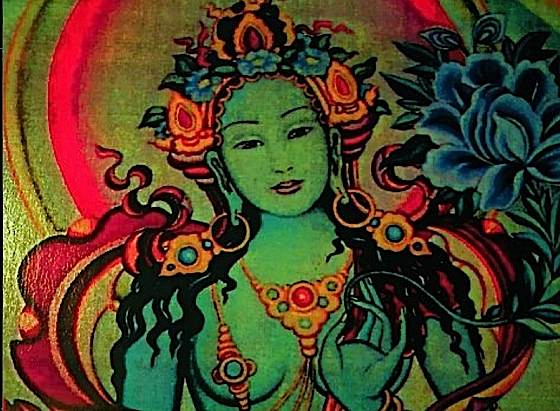 Tara is a lower tantric practice, generally, although Chittimani Tara is a Highest Yoga practice. Lower Tantra does not imply it is less important than Higher Tantra. Tara is a beloved Female Buddha, the active protector.
For an in-depth story on Tara, please see>>
For an in-depth story on Vajrayogini, please see>>
Tara is a lower tantric practice, generally, although Chittimani Tara is a Highest Yoga practice. Lower Tantra does not imply it is less important than Higher Tantra. Tara is a beloved Female Buddha, the active protector.
For an in-depth story on Tara, please see>>
For an in-depth story on Vajrayogini, please see>>
Different aspects of Wisdom
In explaining the differences between these aspects of Buddha, His Holiness describes Green Tara:
“Tara is more for helping develop common siddhis [someone who has attained enlightenment or a paranormal power possessed by a siddhi], for instance, to prevent disasters and to protect you from evil on the path. If you use it for your own personal benefit, that is not the right way. It is for achieving the ultimate goal and helping all beings. You need a long life and wealth and health for that. If you are involved in Tara’s blessings for that reason, that is the right idea, but it is not just for the worldly benefits. It’s like asking a great emperor to sweep the house.”
On the other hand, they are also clearly the same. His Holiness explains:
“Actually these deities are … the manifestation, of the ultimate truth. The female deities are more on the wisdom side and the male deities are more on the method [compassion] side. But the ultimate, actual transcendental knowledge of wisdom is the complete union of these two things. So they are not really separate.”
It is the Female Buddha’s role as “wisdom personified” that not only makes Her practice important but also leads to the vast diversity of symbolism between Her many aspects.
Divine Mother or Blissful Wisdom?
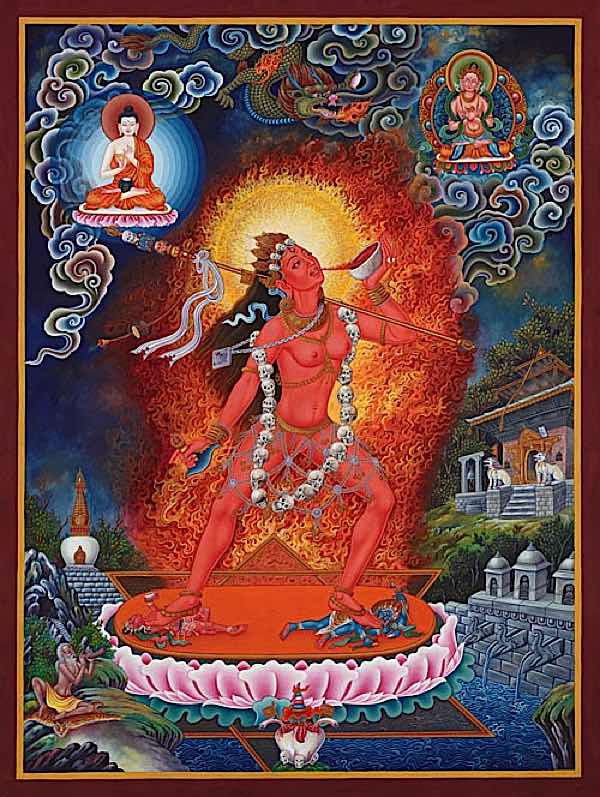 Robert Beer’s beautiful Vajrayogini mandala. (Low resolution: please visit https://www.tibetanart.com for information on high resolution images)
Robert Beer’s beautiful Vajrayogini mandala. (Low resolution: please visit https://www.tibetanart.com for information on high resolution images)While most Vajrayana Buddhists categorize the different aspects of Buddha as one of four classes of Tantra — described this way, in part, to emphasize the practice emphasis — scholars tend to categorize Tara as a Mahayana practice and Vajrayogini as a Tantric practice.
His Holiness Sakya Trizin points out that Tara can be found in all four classes of Tantra, “whereas Vajrayogini is only in Anuttara Yoga Tantra, which is the highest class of Tantra. They are both, in reality, Prajna Paramita, or the ultimate transcendental wisdom, but in form they are very different. The main emphasis of Vajrayogini, of course, is only achieving enlightenment for the benefit of others.”
Tara is unique, as she was the first Mahayana deity to explicitly be titled a “Female Buddha.” Scholars, such as Miranda Shaw tend to place Tara within the broader Mahayana practices, and Vajrayogini (Vajravarahi) within the Tantric Vajrayana influence. She draws a clear line of demarcation — one scholars are more likely to do, than practitioners:
“A clear line of demarcation can be drawn in the… two classes of female deities. The female divinities featured in Mahayana practice are primarily… divine mothers and Dharani (mantra) goddesses. They are… supplicated and invoked as saviouresses who are tremendously evolved and have extraordinary powers for helping and liberating others… In Tantric tradition, the sacred female completed her ascent and attained the highest stature possible in Buddhism, namely Buddhahood….”
Serene and motherly; or ferociously compassionate?
She goes on, in a scholarly way, to compare iconographic conventions: “The iconography of Vajrayoini, and indeed all Tantric Female Buddhas differs markedly from the goddess characteristic of the Mahayana… Mahayana divine females are usually shown in a regal seated posture, modestly and sumptuously clothed in silken raiment, draped with jeweled adornments, and elaborately coifed… Their faces glow with maternal warmth and compassion, while their attributes reflect their specific ministrations and liberative activities. The noteworthy exception to this pattern is Tara, who is explicitly recognized and titled as a Buddha…”
“In contrast, Tantric Buddhas such as Vajrayogini have a more dynamic passionate persona… Their faces exhibit intense concentration and even ferocity. Their bodies are unclothed, and their hair unbound in the fashion of female ascetics and yoginis. Their bone ornaments betoken a nondualistic outlook and familiarity with the charnel ground, while their handheld attributes allude to their attainment of supreme bliss and wisdom.”
His Holiness Sakya Trizin describes the symbolism
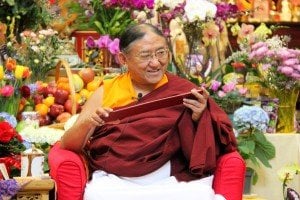 His Holiness Sakya Trizin
His Holiness Sakya TrizinHis Holiness the Sakya Trizin, describes them with similar language: “Actually, Vajrayogini has many different forms, but the one we normally use is in between wrathful and peaceful. She is usually in the red color, with one face and two hands holding a curved knife and skull cup filled with nectar and she is adorned with bone ornaments. All these different ornaments and objects have many very deep meanings. The curved knife usually represents the fact that she cuts all defilements. The cup represents what in Sanskrit is called mahasukha, which means “the great bliss.” She is in a complete state of great bliss all the time.
“Tara usually has her right hand in what we call the “giving gesture.” She is bestowing siddhis on all beings. The left one is holding the utpala flower, which represents the many qualities of the Buddhas.” [4]
Practice differences
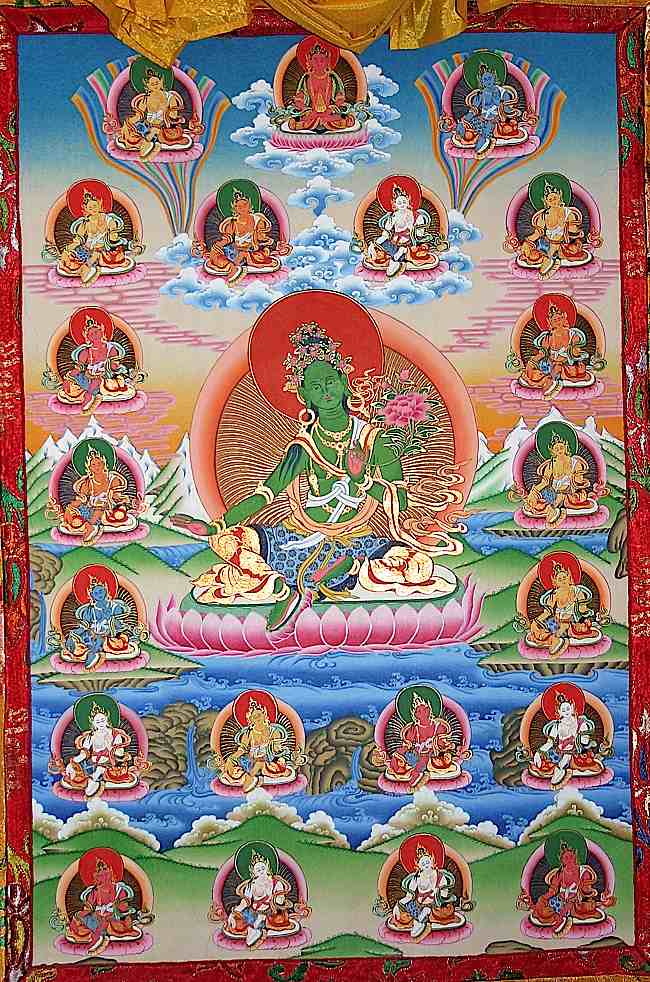 The 21 forms of Tara include White Tara and Green Tara, among the most beloved deities in Tibetan Buddhism.
The 21 forms of Tara include White Tara and Green Tara, among the most beloved deities in Tibetan Buddhism.While Tara is famous for her many practice and meditational forms — 21 Taras, 108 Taras, White Tara, Green Tara, and her Highest Yogic aspect Chittamani Tara — Vajrayogini is equally diverse, but in a strikingly different way. She can be the consort (representing Wisdom) of many Buddhas: Chakrasamvara, Hayagriva, and many others. Tara can be found in all of the four classes of Tantra yogas, while Vajrayogini is only found in the Highest Yogic practices. Tara is famously associated with praises and supplications for aid in our daily lives and practices; Vajrayogini is, on the other hand, most notably associated with supreme practices such as the Six Yogas of Naropa, the Eleven Yogas of Vajrayogini, and, of course Tummo — all advanced practices.
For a feature on the 21 Taras, see>> For a feature on the Highest Yoga Tantra Tara Chittamani Tara, see>>Both Tara and Vajrayogini are also known for their mantras. Tara’s mantra, Om Tare Tuttare Ture Svaha, is chanted by millions around the world, and is well known for its effectiveness. A practice of Tara can be simply that — her mantra. Likewise, Vajrayogini is well known for the practice of her mantra — which is not published here, as it’s best to have initiation and instruction into her practice first. Vajrayogini’s practice is also considered a powerful, complete practice. This is somewhat unique amongst Highest Yoga Tantra deities. Chanting Vajrayogini’s mantra can lead to Enlightenment if chanted by a person of complete faith.
In other words, their mantras, just like their aspects, have different aspects and emphasis, but they are the same at the core. Tara, as a Buddha found in all four classes of tantra, is diverse, and can help us in many ways. Vajrayogini tends to be more focused almost on Enlightenment. Her dance transcends mundane concerns. But, she is still a mother, who loves her children, and there are countless stories of her saving and helping her followers. Her approach may be more dynamic and fierce, but she is still, in essence, the Female Buddha.
A different type of saviour
While Tara might save a man drowning in the river, Vajrayogini is seen as a saviour in a different way.
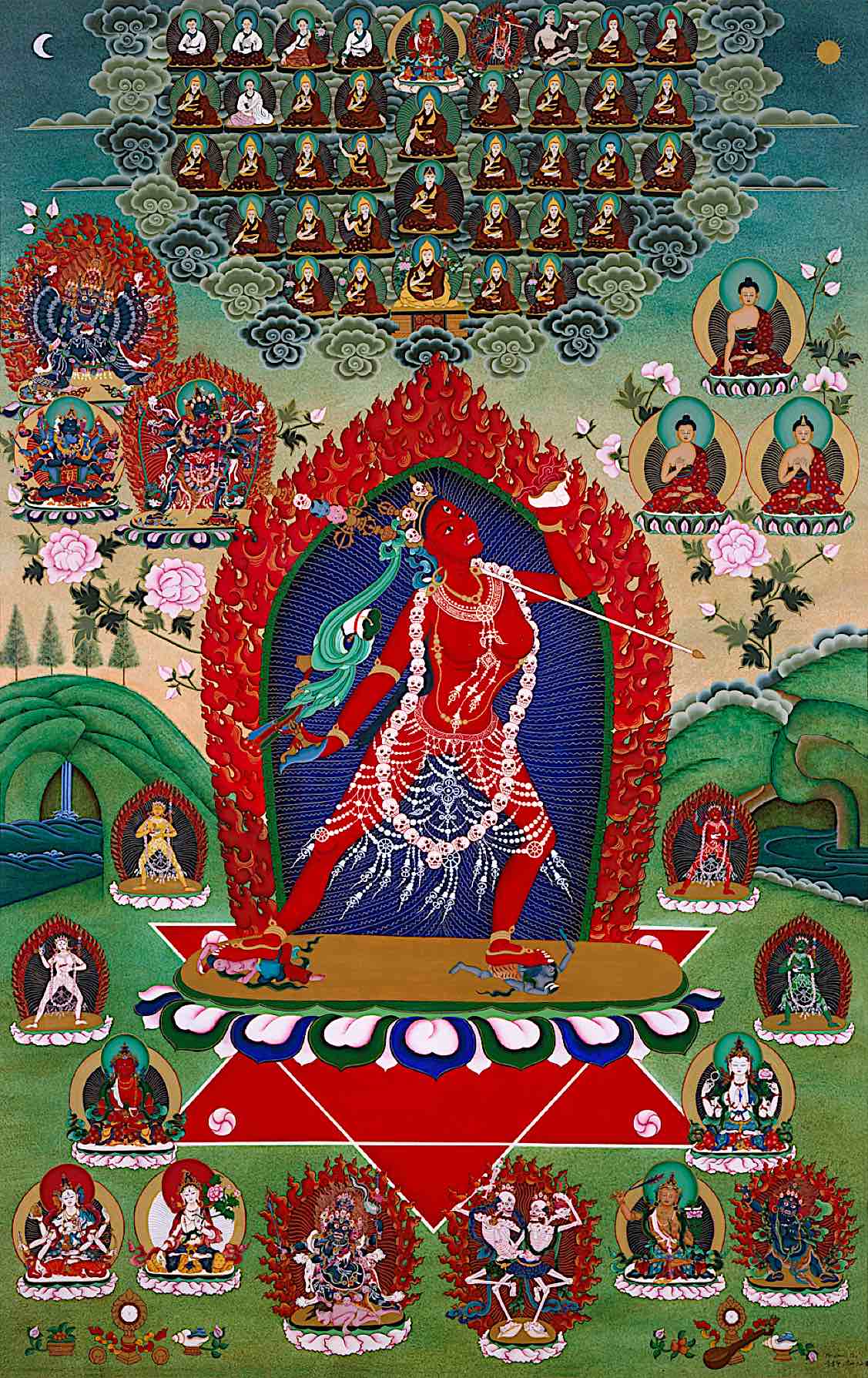 This complex thangka depicts the various lineage masters going all the way back to Buddha Vajradhara, who is actually Buddha Shakyamuni is tantric form. At the upper left are the main tantric deities – Yamantaka, Heruka Chakrasamvara and Guhyasamaja. At the upper right are the Buddhas of the past and present – Krakucchanda, Kasyapa and Shakyamuni. At the bottom left are the three long-life deities – Amitayus, Namgyalma and White Tara. At the bottom right are Chenrezig, Manjushri and Vajrapani, who, taken together can be said to represent Lama Tsongkhapa, the great 14th century Tibetan scholar and saint who is an emanation of these three great Buddhas. Below Vajrayogini are two Dharma Protectors – 4-faced Mahakala (a wrathful emanation of Heruka) and Citipati, the special Protector for Vajrayogini practitioners.
This complex thangka depicts the various lineage masters going all the way back to Buddha Vajradhara, who is actually Buddha Shakyamuni is tantric form. At the upper left are the main tantric deities – Yamantaka, Heruka Chakrasamvara and Guhyasamaja. At the upper right are the Buddhas of the past and present – Krakucchanda, Kasyapa and Shakyamuni. At the bottom left are the three long-life deities – Amitayus, Namgyalma and White Tara. At the bottom right are Chenrezig, Manjushri and Vajrapani, who, taken together can be said to represent Lama Tsongkhapa, the great 14th century Tibetan scholar and saint who is an emanation of these three great Buddhas. Below Vajrayogini are two Dharma Protectors – 4-faced Mahakala (a wrathful emanation of Heruka) and Citipati, the special Protector for Vajrayogini practitioners.For example, there is the story of the novice monk Kusali who saw a leper woman unable to cross the Ganges river. All the other monks ignored the sick woman, afraid of contagion, but he had compassion and carried her on his back across the river. Half way accross the river, he suddenly found himself bodily dangling in the air, rising above the river. In fact, the leper woman had been Vajrayogini, and by showing compassion, She took him immediately to her Pure Land, Kechara. There are numerous stories of Vajrayogini coming to her followers, and immediately taking them to her pure land.
Miranda Shaw explains: “Vajrayogini is, first and foremost, an enlightened being. She has attained full awakening and manifests a divine body that expresses her spiritual realizations, providing a model on which others may meditate in order to attain the same goal. As an enlightened being, Vajrayogini has attained both transcendent wisdom (prajna) and supreme bliss (mahasukha)… She possesses the five transcendent insights of a Buddha and the essences of spontaneously arising bliss.” [2]
The goal of Enlightenment — and the role of Bliss
The ultimate goal of Enlightenment remains the same in all practices, Tara, Vajrayogini and others. However, the yogi or yogini who practices Vajrayogini intensely focuses on the goal of Enlightenment through the introduction of bliss to help us embrace Emptiness without nihilism.
[For more on the role of “Bliss” in Vajrayana, see>>]Gelek Rinpoche explained [5]:
“Emptiness is not a specialty of Vajrayana. Yidam meditation is part of Vajrayana, but is not the special quality of the Vajrayana. The special quality [that enhances the practice] really is the bliss.”
Pabongka, put it this way:
“Within that bliss, the subtle primordial mind observes the object, emptiness. This is the most difficult, very subtle point of Vajrayana, the union of bliss and void.”
The most venerable late Gelek Rimpoche explained it with a stage-play metaphor:
“Let’s say I am the Vajrayana, I am sitting on the stage. If there is no stage, I can’t sit on the stage, right? The stage of Vajrayana is bliss and void. If there is no void, you have no stage. Bliss and void are the Vajrayana stage, the Vajrayana base. All the performances that are done in Vajrayana are done on the stage of bliss and void.” [5]
The feeling of bliss overlays everything in Vajrayana practice. Even when we describe the Purelands — which many people think of as a state of mind — we often use the word “bliss” to describe it. It’s peaceful and blissful. Not just blissful, but the ultimate form of bliss — an ecstatic, perfect bliss. Not a temporary bliss, like that of an orgasm, but permanent, sustained bliss that only comes from realizations of the true nature of reality.
NOTES
[1] Buddhist Goddesses of India (Hardcover) by Miranda Shaw
[2] Ibid, Chapter 18
[3] Precious Human Rebirth
[4] Interview with His Holiness Sakya Trizin: Understanding the Tantric Tradition’s 3 Major Deities: Trike Daily
[5] Cittamani Tara Teachings Gelek Rimpoche Jewel Heart Sangha (PDF)

 Hollif
Hollif 








